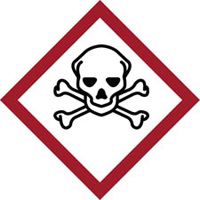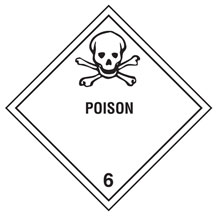



Find all of your laboratory and workplace safety supplies at Safety Emporium!
 Pneumoconiosis |
 Glossary Index |
 Polymer |
| MSDS Topics |
Free Sites | FAQ's | Regulations | Glossary | Software | Suppliers |
| Books | Forum | Poll | Fun stuff | Quiz | Store | |
| Understand your MSDS with the MS-Demystifier | Search ALL our MSDS info | |||||
A poison is a substance that adversely affects one's health by causing injury, illness, or death. These are often marked with a skull and crossbones as shown on the right, below.
A substance that counteracts the effects of a poison is called an antidote.

Get your GHS-compliant labels and signs from Safety Emporium.
NOTE: We may collect a share of sales or other compensation from the links in the following list:

Be sure you're in compliance with DOT placards and labels from Safety Emporium.
Treat poisonous materials with respect! Read the Safety Data Sheet to find out what ways a poison can kill you -- is it by inhalation, ingestion and/or skin contact? What precautions should you take with the material? What kinds of personal protective equipment (PPE) are recommended?
Remember to read the material label and SDS if a poison is ingested. For example, it is often bad to induce vomiting because some materials can cause additional chemical burns to the throat and esophagus upon regurgitation. If in doubt, contact the nearest emergency room or call the American Association of Poison Control Centers poisoning emergency number (800) 222-1222.
Don't fool around with poisons. Treat them with great respect at all times.
See also: activated charcoal, antidote, catharsis, cytotoxin, emetic, mus (mouse), Swiss Poison Class, toxic
Additional definitions from Google and OneLook.
Entry last updated: Saturday, January 7, 2023. This page is copyright 2000-2025 by ILPI. Unauthorized duplication or posting on other web sites is expressly prohibited. Send suggestions, comments, and new entry desires (include the URL if applicable) to us by email.
Disclaimer: The information contained herein is believed to be true and accurate, however ILPI makes no guarantees concerning the veracity of any statement. Use of any information on this page is at the reader's own risk. ILPI strongly encourages the reader to consult the appropriate local, state and federal agencies concerning the matters discussed herein.